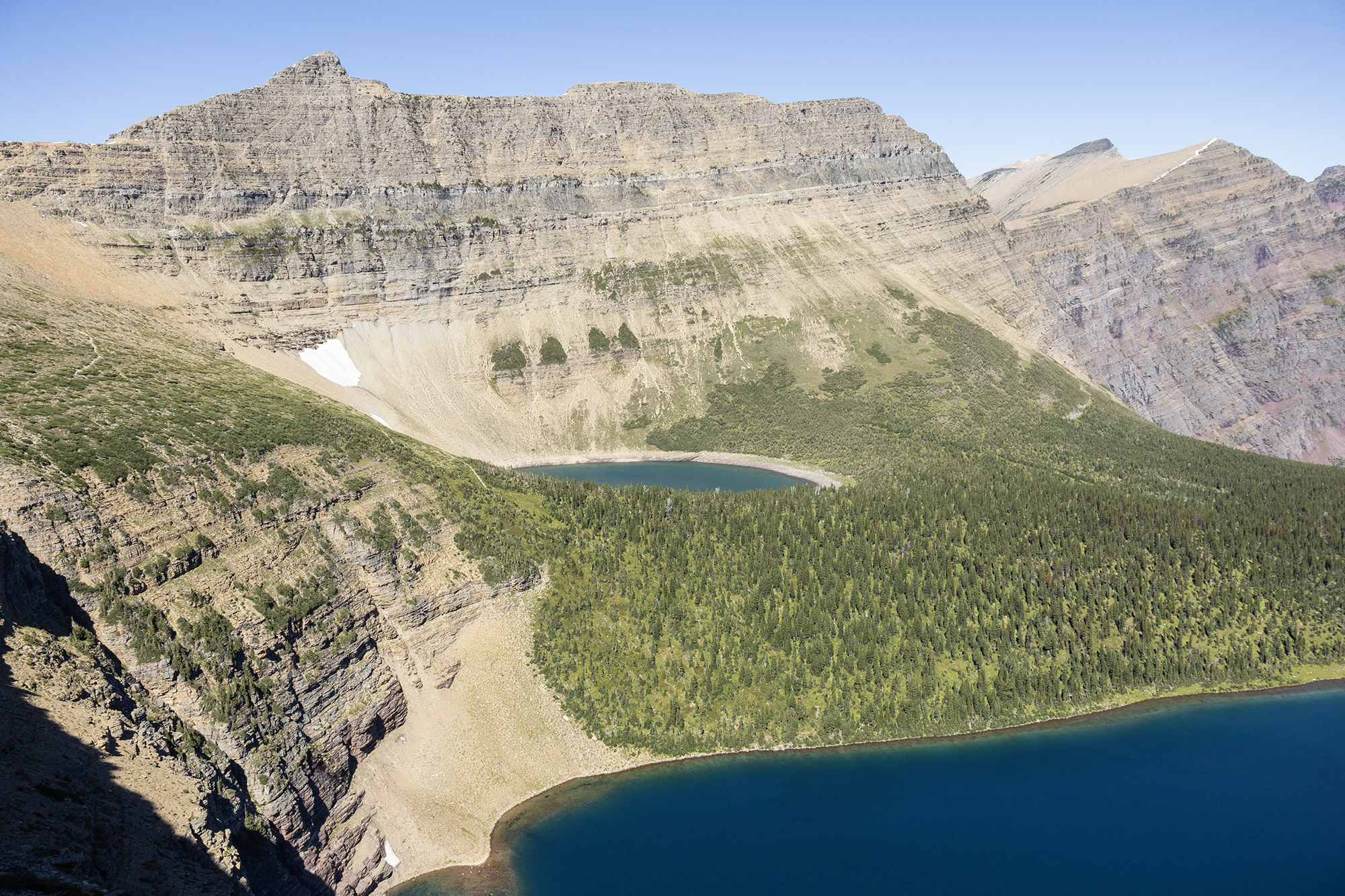Pitamakan Pass in the Two Medicine area of Glacier National Park straddles two gorgeous drainages filled with stunning lakes and craggy peaks… oh and the huckleberries can be really good too!
We rolled up to the trailhead at Pray Lake as the sun was coming over the horizon. Armed with a scope, tripod, and binoculars, we hit crossed over the bridge and started our journey.
Sometimes we step out onto the trail with a mountain summit in mind. Sometimes the destination is a lake or just to do a big loop. Sometimes it’s for the flowers or to look for birds, but today, we were out do gather some data for Glacier’s citizen science program. We were looking for Mountain Goats and Bighorn Sheep.
The trees and bushes blew in the wind, typical for Two Medicine, as we hiked up through the trees and out to an avalanche chute that gave vantages of the Two Medicine River and the campground that we’d just left. More treed walking as we went up onto the ridge that extends from Rising Wolf, before turning up the Dry Fork Drainage.
If you keep your eyes up towards Rising Wolf to your left, you’ll get a pretty view of the waterfall coming down from Sky Lake, even into August. The trail switchbacked down to meadows lined with trees before popping out to the Dry Fork crossing. Aptly named, the creek was nowhere to be seen, although its rocky bed tells the story of a creek that flows through here every spring. It’s not that the creek isn’t running, in fact further up, it’s flowing just fine. Here, however, it’s running well beneath the boulders.
After crossing the stream, we entered back into the dry, lodgepole forest with low growing huckleberry plants. Sections of the trail pass through wetter areas where the thimbleberry were head high and the aspens higher still. As we gained elevation, the forest changed with it, giving us beargrass meadows and the wonderful vantage looking up to the head of the valley. The pyramid-shaped Flinsch Peak and rounded block of Mt Morgan beckon you further.
A flock of grouse blocked the trail as we moved through the forest. Interestingly, it was a mixed flock of Spruce Grouse and Dusky Grouse with the latter being about 25% larger than the first, but the former certainly are more handsome with their more defined barring and the male with his lovely blacks and grays, and a red comb over his eyes.
Eventually we entered the more open area where the unobstructed views delighted. Rising Wolf, on the opposite side of the valley, is just a beast of a mountain. Reds, grays, browns, all the colors of the rocks that make up this long ridgeline with multiple lakes tucked up below its cliffs. One such unnamed lake became visible as we climbed higher and higher.
We finally reached the basin that hold Old Man Lake. Tall, gray snags of dead Whitebark Pines let us know we were close to the campground. While we’d encountered huckleberries throughout the hike, this area was an embarrassment of riches. They were not only delicious and plentiful, but HUGE! We snacked on them and promised ourselves that, if we had time on the way back, we’d gather some to take home.
Bypassing the lake this time, we looked up to see Pitamakan Pass, where our designated observation point sat. Up we went, switchbacking along the ridge. Old Man Lake became visible before we even reached the first switchback and seemed to get prettier with every step.
After a few more switchbacks and a few more stops to catch our breath, we finally crested the ridge to peer into the Cutbank Drainage. The view looking down at Pitamakan Lake never gets old, with its stunning blue waters. A kaleidoscope of colored peaks stretch out in the distance.
Lunch was first, so we got out of the wind and found sustenance. A stream of Continental Divide Trail hikers passed by, almost finishing their epic journeys that started at the border between the US and Mexico. We were content to sit for a bit.
Out came the scopes and the binoculars and we began our protocol of dividing the landscape up into four quadrants (NW, NE, SW, SE) and began our survey. After a bit of looking, we found a Mountain Goat feeding along the flanks of McClintock Mountain, but no other target animals.
What we did find, however, foraging in the talus slopes on both Rising Wolf Mountain and Red Mountain were grizzlies! At about 9,000ft, we saw a sow and a cub near the top of Rising Wolf Mountain. The sow was moving rocks around, looking for delicious Cutworm Moths (full of protein and fat) while her cub ran up and down the snowy slopes. On Red Mountain, another sow, this one with two cubs, and two other adult bears turned over the brown boulders while Common Ravens hopped around to snatch up moths that were flying away from the bears’ claws and jaws.
After we finished up our survey, it was time to pack up and head down. On our way down we spied some raptors and some smaller birds gaining quick elevation on the wind as it raced up and over the mountains. We stopped in the huckleberry patch and quickly filled up a quart bag with nature’s bounty and headed back to our car.





Leave a Reply